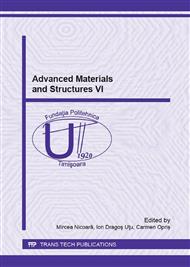[1]
T. Sadowski, S. Ataya, K. Nakonieczny, Thermal analysis of layered FGM cylindrical plates subjected to sudden cooling process at one side – comparison of two applied methods for problem solution, Comp. Mater. Sci. 45 (2009) 624-632.
DOI: 10.1016/j.commatsci.2008.07.011
Google Scholar
[2]
K. Nakonieczny, T. Sadowski, Modelling of thermal shock in composite material using a meshfree FEM, Comp. Mater. Sci. 44 (2009) 1307-1311.
DOI: 10.1016/j.commatsci.2008.08.019
Google Scholar
[3]
T. Sadowski, K. Nakonieczny, Thermal shock response of FGM cylindrical plates with various grading patterns, Comput. Mat. Sci. 43 (2008) 171-178.
DOI: 10.1016/j.commatsci.2007.07.051
Google Scholar
[4]
V. Birman, L.V. Bryd, Modelling and Analysis of Functionally Graded Materials and Structures. Appl. Mech. Rev. 60 (2007) 195-216.
Google Scholar
[5]
T. Sadowski, A. Neubrand, Estimation of the crack length after thermal shock in FGM strip, Int. J. Fract. 127 (2004) 135-140.
DOI: 10.1023/b:frac.0000035087.34082.88
Google Scholar
[6]
V. Petrova, T. Sadowski, Theoretical modeling and analysis of thermal fracture of semi-infinite functionally graded materials with edge cracks, Meccanica 49 (2014) 2603–2615.
DOI: 10.1007/s11012-014-9941-x
Google Scholar
[7]
I.V. Ivanov, T. Sadowski T., D. Pietras, Crack propagation in functionally graded strip, European Physical Journal Special Topics 222 (2013) 1587-1595.
DOI: 10.1140/epjst/e2013-01947-3
Google Scholar
[8]
T. Sadowski, S. Hardy, E. Postek, Prediction of the mechanical response of polycrystalline ceramics containing metallic inter-granular layers under uniaxial tension. Comput. Mat. Sci. 34 (2005) 46-63.
DOI: 10.1016/j.commatsci.2004.10.005
Google Scholar
[9]
L.A. Gömze, L.N. Gömze, Alumina-based hetero-modulus ceramic composites with extreme dynamic strength – phase transformation of Si3N4 during high speed collision with metallic bodies, Ĕpitöanyag – Journal of Silicate Based and Composite Materials 61 (2009).
DOI: 10.14382/epitoanyag-jsbcm.2009.7
Google Scholar
[10]
T. Sadowski, E. Postek, Ch. Denis, Stress distribution due to discontinuities in polycrystalline ceramics containing metallic inter-granular layers. Comput. Mat. Sci. 39 (2007) 230-236.
DOI: 10.1016/j.commatsci.2006.03.022
Google Scholar
[11]
E. Postek, T. Sadowski, Assessing the Influence of Porosity in the Deformation of Metal-Ceramic Composites, Composite Interfaces 18 (2011) 57-76.
DOI: 10.1163/092764410x554049
Google Scholar
[12]
M. Daroonparvar, M. A. M. Yajid, N. M. Yusof, S. Farahany, M. S. Hussain, H. R. Bakhsheshi-Rad, Z. Valefi, A. Abdolahi, Improvement of thermally grown oxide layer in thermal barrier coating systems with nano alumina as third layer, Trans. Nonferrous Met. Soc. China 23 (2013).
DOI: 10.1016/s1003-6326(13)62600-x
Google Scholar
[13]
M. Saremi, Z. Valefi, Thermal and mechanical properties of nano-YSZ–Alumina functionally graded coatings deposited by nano-agglomerated powder plasmaspraying, Ceramics International 40 (2014)13453–13459.
DOI: 10.1016/j.ceramint.2014.05.068
Google Scholar
[14]
K.A. Khor, Y.W. Gu, Thermal properties of plasma-sprayed functionally graded thermal barrier coatings, Thin Solid Films 372 (2000) 104-113.
DOI: 10.1016/s0040-6090(00)01024-5
Google Scholar
[15]
H. Chen, X. Zhou, Ch. Ding Investigation of the thermomechanical properties of a plasma-sprayed nanostructured zirconia coating , Journal of the European Ceramic Society 23 (2003) 1449–1455.
DOI: 10.1016/s0955-2219(02)00345-x
Google Scholar
[16]
A. Kawasaki, R. Watanabe, Thermal fracture behavior of metal/ceramic functionally graded materials, Engineering Fracture Mechanics 69 (2002) 1713–1728.
DOI: 10.1016/s0013-7944(02)00054-1
Google Scholar
[17]
T. Sadowski, D. Pietras, I. Ivanov, Estimation of thermal stress intensity factor in a strip with various property gradations subjected to thermal shock, Key Engineering Materials Vol. 601 (2014) 71-75.
DOI: 10.4028/www.scientific.net/kem.601.71
Google Scholar
[18]
Z-H. Jin and G.H. Paulino, Transient thermal stress analysis of an edge crack in a functionally graded material, Int. J. Frac. 107 (2001) 73-98.
Google Scholar
[19]
Y. Jiang, Q. Zheng, P. Dong, J. Yao , H. Zhang, J. Gao, Conjugate heat transfer analysis of leading edge and downstream mist–air film cooling on turbine vane, International Journal of Heat and Mass Transfer 90 (2015) 613–626.
DOI: 10.1016/j.ijheatmasstransfer.2015.07.005
Google Scholar
[20]
M. Schmidt, Ch. Starke, Coupled heat-transfer simulations of turbines in consideration of unsteady flows, International Journal of Thermal Sciences 96 (2015) 305-318.
DOI: 10.1016/j.ijthermalsci.2015.02.015
Google Scholar
[21]
T. Sadowski, P. Golewski, Multidisciplinary analysis of the operational temperature increase of turbine blades in combustion engines by application of the ceramic thermal barrier coatings (TBC), Comp. Mater. Sci. 50 (2011) 1326-1335.
DOI: 10.1016/j.commatsci.2010.05.032
Google Scholar
[22]
T. Sadowski, P. Golewski, The influence of quantity and distribution of cooling channels of turbine elements on level of stresses in the protective layer TBC and the efficiency of cooling, Comp. Mater. Sci. 52 (2012) 293-297.
DOI: 10.1016/j.commatsci.2011.02.027
Google Scholar
[23]
T. Sadowski, P. Golewski, Detection and numerical analysis of the most efforted places in turbine blades under real working conditions, Comp. Mater. Sci. 64 (2012) 285-288.
DOI: 10.1016/j.commatsci.2012.02.048
Google Scholar
[24]
T. Sadowski, S. Samborski, Development of damage state in porous ceramics under compression, Comp. Mater. Sci. 43 (2008) 75-81.
DOI: 10.1016/j.commatsci.2007.07.041
Google Scholar


